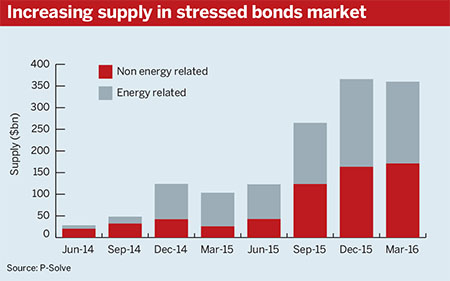From the blog: Corporate bonds issued by companies perceived to be under financial stress are currently trading at very low prices. This could be an attractive investment opportunity.
The opportunity is hiding in a corner of the high-yield debt market referred to as ‘stressed’ bonds – corporate bonds that have fallen significantly in price, typically below 80c of par value ($1), but which unlike ‘distressed’ bonds have not actually defaulted.
The fall in price has usually occurred because the market believes the risk of default has increased.
The opportunity is hiding in a corner of the high-yield debt market referred to as ‘stressed’ bonds – corporate bonds that have fallen significantly in price, typically below 80c of par value ($1), but which unlike ‘distressed’ bonds have not actually defaulted.
The fall in price has usually occurred because the market believes the risk of default has increased.
But not all bonds that fall into the stressed universe go on to default; historically, on average, only about 20 per cent of them have done so.
If investors purchase stressed bonds at a price significantly below par – and the issuing company does not default – then substantial returns can be made.
Investors are fewer and more cautious
Since mid-2014, the credit market has become more cautious. Energy and commodity-related companies are under a lot of stress, and the wider economy is softening.
Many investors are reducing their riskier credit investments, and active managers are cutting positions at the first sign of trouble.
There are also fewer buyers; hedge funds have access to less capital, and new capital regulations have forced most bank trading desks to close or shrink significantly.
The upshot is that companies’ bond prices plummet at the first sign of difficulty. As a result, the universe of stressed bonds is both larger and cheaper than historical precedents would have led us to expect.

Many attractive bonds are trading at 50c in the dollar.
Suppose such a bond has four years until maturity and an 8 per cent coupon. If everything goes well, each 50c invested generates 8c of cash income each year.
Then there is a capital gain when you are paid back the full $1 in four years’ time. This represents a total cash-on-cash profit of 164 per cent on the investment.
Of course, not every investment will turn out so perfectly. Some bonds will default.
Suppose a default happens halfway through the investment, after two years of coupons have been paid, totalling 16c.
And suppose some of the bond value is recovered, at the historical average rate of 35 per cent. We would again make a cash-on-cash profit on the investment, this time of 2 per cent.
Of course, these outcomes are part of a wide range of what’s possible – but they illustrate the crucial point.
Pricing at this level really doesn’t make sense. It would take a broad and deep US recession to justify these prices, which is not likely at the moment.
Ravi Cheema is a senior investment associate at consultancy P-Solve












